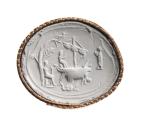Advanced Search
Oval gem with the story of Jonah
Roman
Imperial Period
late 3rd or early 4th century A.D.
Place of Manufacture: East Mediterranean, East Mediterranean
Medium/Technique
Carnelian
Dimensions
Length: 1.5 cm (9/16 in.)
Credit Line
Bartlett Collection—Museum purchase with funds from the Francis Bartlett Donation of 1900
Accession Number03.1008
CollectionsJewelry, Ancient Greece and Rome
ClassificationsJewelry / Adornment – Gems
The Jonah cycle was the first biblical narrative regularly depicted by artists in early Christian communities, who may have drawn inspiration from illustrated books that do not survive. Both eastern and western Mediterranean renderings of the story have been found, dating from as early as the late third century A.D., in contexts ranging from intimate personal objects such as rings to large-scale images carved on sarcophagi and painted on the walls of the catacombs.
This small engraved gemstone skillfully compresses several episodes from the Book of Jonah into a single scene. The prophet stands to the left with his arms raised, perhaps in a gesture of prayer as he receives the summons from God to warn the city of Nineveh of its impending destruction. In the center, a ship is steered by a sailor seated in the stern, while Jonah dives headfirst into the sea toward a sea monster that is approaching open-mouthed, ready to swallow him. Jonah's reappearance at the right signifies his deliverance from the belly of the monster after three days; he sits under a leafy tree on which a bird is perched, a shorthand representation of the dry land onto which the sea monster cast him.
The popularity of the Jonah story is surely explain-ed by its symbolic significance for ordinary Christians living in the Roman world. The gospels themselves invited an allegorical reading: "For as Jonah was three days and three nights in the whale's belly; so shall the Son of man be three days and three nights in the heart of the earth" (Matt. 12:38-40). Early followers of Christ undoubtedly identified with Jonah's plight and found hope for their own salvation in his deliverance.
This small engraved gemstone skillfully compresses several episodes from the Book of Jonah into a single scene. The prophet stands to the left with his arms raised, perhaps in a gesture of prayer as he receives the summons from God to warn the city of Nineveh of its impending destruction. In the center, a ship is steered by a sailor seated in the stern, while Jonah dives headfirst into the sea toward a sea monster that is approaching open-mouthed, ready to swallow him. Jonah's reappearance at the right signifies his deliverance from the belly of the monster after three days; he sits under a leafy tree on which a bird is perched, a shorthand representation of the dry land onto which the sea monster cast him.
The popularity of the Jonah story is surely explain-ed by its symbolic significance for ordinary Christians living in the Roman world. The gospels themselves invited an allegorical reading: "For as Jonah was three days and three nights in the whale's belly; so shall the Son of man be three days and three nights in the heart of the earth" (Matt. 12:38-40). Early followers of Christ undoubtedly identified with Jonah's plight and found hope for their own salvation in his deliverance.
Catalogue Raisonné
Highlights: Classical Art (MFA), p. 050.
DescriptionAt left, a man (probably Jonah) with arms lifted in prayer or speech. In the center, Jonah plunges from a ship towards a sea monster, while a sailor prays. At right, an older, bearded Jonah with a staff sits under a tree with a bird perched at the top. Small chips missing at left and right; surface abraded. Reddish carnelian. Oval intaglio with flat front; set in modern gold ring.
ProvenanceBy date unknown: with Edward Perry Warren (according to Warren's records: bought in London); purchased by MFA from Edward Perry Warren, March 1903



